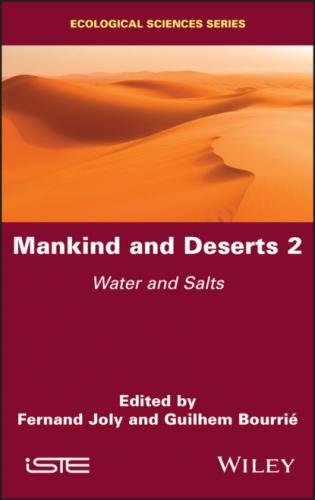124 114
125 115
126 116
127 117
128 118
129 119
130 121
131 122
132 123
133 124
134 125
135 126
136 127
137 128
138 129
139 130
140 131
141 132
142 133
143 134
144 135
145 136
146 137
147 139
148 141
149 142
150 143
151 144
152 145
153 147
Series EditorFrançoise Gaill
Mankind and Deserts 2
Water and Salts
Edited by
Fernand Joly
Guilhem Bourrié
First published 2021 in Great Britain and the United States by ISTE Ltd and John Wiley & Sons, Inc.
Apart from any fair dealing for the purposes of research or private study, or criticism or review, as permitted under the Copyright, Designs and Patents Act 1988, this publication may only be reproduced, stored or transmitted, in any form or by any means, with the prior permission in writing of the publishers, or in the case of reprographic reproduction in accordance with the terms and licenses issued by the CLA. Enquiries concerning reproduction outside these terms should be sent to the publishers at the undermentioned address:
ISTE Ltd
27-37 St George’s Road
London SW19 4EU
UK
John Wiley & Sons, Inc.
111 River Street
Hoboken, NJ 07030
USA
© ISTE Ltd 2021
The rights of Fernand Joly and Guilhem Bourrié to be identified as the authors of this work have been asserted by them in accordance with the Copyright, Designs and Patents Act 1988.
Library of Congress Control Number: 2020949240
British Library Cataloguing-in-Publication Data
A CIP record for this book is available from the British Library
ISBN 978-1-78630-631-9
Foreword
Mankind and deserts
Fernand Joly1 departed from this world before he was able to complete this book, through which he had hoped to share his experiences of and passion for deserts.
“Yet another book on deserts!” some might think; another book to add to the numerous publications dedicated to these alien and fascinating worlds.
This book, however, is different from earlier books, as can be seen from its title “Mankind and Deserts”. It is based on the singular relationships that are formed between humans and the world of the desert – relationships that are unique because they can be traced back to the very origins of humanity. Indeed, it is from the arid Horn of Africa (East Africa) that large migrations began and it is along the deserts, if not within the deserts themselves, that we find the major cradles of burgeoning historical civilizations. This inhospitable world is also associated with great spiritual leaders such as Moses, Jesus, Mohammed and the Buddha, while serving as the backdrop for adventurers and empire builders from Alexander the Great to Genghis Khan, or from the Incans to the Conquistadors in the Andes and Mexico.
What is this universe that is so barren and yet so mesmerizing?
“All about a word” was how Fernand Joly introduced his book: “What is a desert?” The ambiguity in this word results from the fact that it has been used in different senses across literature and throughout history. For a geographer-writer such as Fernand Joly, the one fact that stood out was that there was no one desert; instead there were multiple deserts, diverse and varied, ranging from Death Valley to the Kalahari, from the Namib to the Atacama or the Gobi desert. Each of these is a unique landscape, whose uniqueness was born out of its position with respect to the general atmospheric circulation, its geographic location with respect to the sea and to its relief features. And yet, transcending all differences, there is one constraint that binds them all together: aridity, defined as a natural physical state characterized by persistent dryness with the corollary of extremely scarce water resources. Both these concepts, aridity and water, are at the heart of the following chapters. Aridity (Chapter 3) because it “transcends time and takes over space” and water (Volume 2, Chapters 1–3) because it is the essential resource for all life, especially in the desert. Aridity is distinct from “drought”, which is simply a “period with insufficient rainfall”. Water is seen through the lens of how it appears on land: “wild water”, which flows over slopes in an un-channeled manner (Volume 2, Chapter 1), under the impact of violent but brief downpours, and “concentrated waters”, i.e. waters “concentrated” into a channel, fed by distant precipitation upstream of the borders of the desert. As can be seen, there is in fact a true hydrography of the arid world. Satellite images, among other sources, offer us clear and accurate reproductions of these systems: fossil hydrographic networks, the legacy of ancient humid periods, a map of intermittent water bodies (Volume 2,
